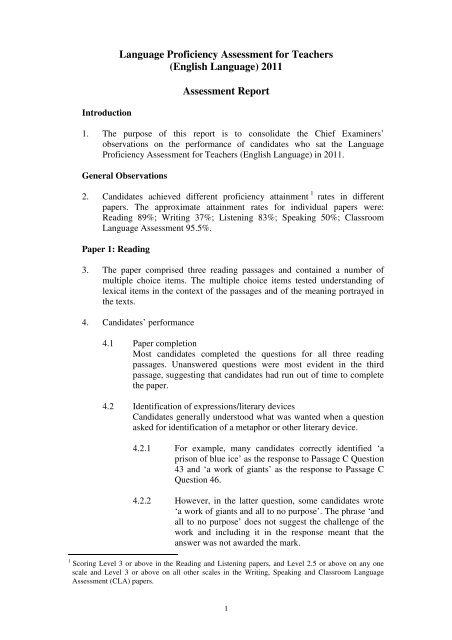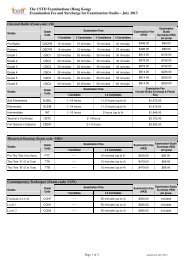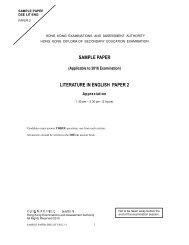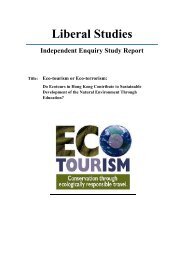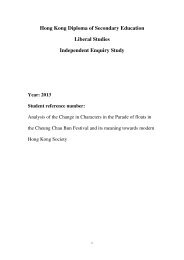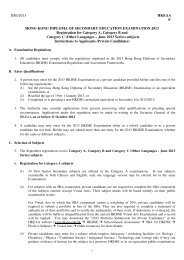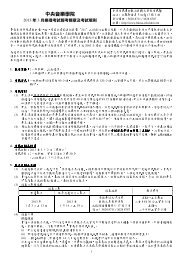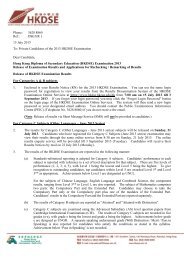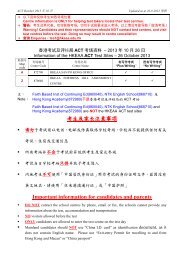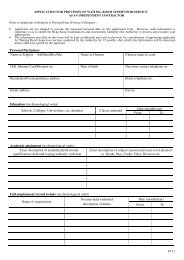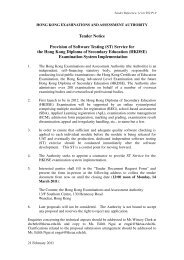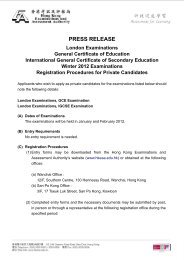(English Language) 2011 Assessment Report
(English Language) 2011 Assessment Report
(English Language) 2011 Assessment Report
- No tags were found...
Create successful ePaper yourself
Turn your PDF publications into a flip-book with our unique Google optimized e-Paper software.
Introduction<strong>Language</strong> Proficiency <strong>Assessment</strong> for Teachers(<strong>English</strong> <strong>Language</strong>) <strong>2011</strong><strong>Assessment</strong> <strong>Report</strong>1. The purpose of this report is to consolidate the Chief Examiners’observations on the performance of candidates who sat the <strong>Language</strong>Proficiency <strong>Assessment</strong> for Teachers (<strong>English</strong> <strong>Language</strong>) in <strong>2011</strong>.General Observations2. Candidates achieved different proficiency attainment 1 rates in differentpapers. The approximate attainment rates for individual papers were:Reading 89%; Writing 37%; Listening 83%; Speaking 50%; Classroom<strong>Language</strong> <strong>Assessment</strong> 95.5%.Paper 1: Reading3. The paper comprised three reading passages and contained a number ofmultiple choice items. The multiple choice items tested understanding oflexical items in the context of the passages and of the meaning portrayed inthe texts.4. Candidates’ performance4.1 Paper completionMost candidates completed the questions for all three readingpassages. Unanswered questions were most evident in the thirdpassage, suggesting that candidates had run out of time to completethe paper.4.2 Identification of expressions/literary devicesCandidates generally understood what was wanted when a questionasked for identification of a metaphor or other literary device.4.2.1 For example, many candidates correctly identified ‘aprison of blue ice’ as the response to Passage C Question43 and ‘a work of giants’ as the response to Passage CQuestion 46.4.2.2 However, in the latter question, some candidates wrote‘a work of giants and all to no purpose’. The phrase ‘andall to no purpose’ does not suggest the challenge of thework and including it in the response meant that theanswer was not awarded the mark.1Scoring Level 3 or above in the Reading and Listening papers, and Level 2.5 or above on any onescale and Level 3 or above on all other scales in the Writing, Speaking and Classroom <strong>Language</strong><strong>Assessment</strong> (CLA) papers.1
4.3 Understanding what questions were testing4.3.1 In Passage A, Question 7 asked ‘What gave rise to EliWhitney’s invention’, the correct response being theneed to replace laborious hand cleaning, not thereplacement of that hand cleaning.4.3.2 In Passage B, Question 24 asked ‘…“to protect”. Fromwhat?’, therefore asking the candidates to respond withthe threat to the paperback business model. A correctresponse referred to invasion by e-readers or competitionfrom Apple, Amazon and Sony.4.3.3 In Passage B, Question 29 asked ‘Why are publishersconsidering supplying books electronically?’ Carefulreading provides the reason: their revenues are dwindlingand the paperback market has shrunk significantly. Somecandidates responded along the lines of ‘as long as theycould be sure that they would profit from it’; this wouldbe the answer to a different question, such as ‘Underwhat condition might publishers agree to supply bookselectronically?’.4.3.4 In Passage B, Question 23 asked ‘What factors…?’ Mostcandidates responding to the question recognised thatthere would be more than one factor involved. Similarly,in Passage C Question 39, the question ‘Who aretalking?’ signalled the fact that there was more than oneperson to be identified in the answer.4.4 Identification of referentsOverall, candidates performed quite well on questions requiringidentification of specific information in the passages; for example,in Passage A Questions 1 and 6.However, in responding to Passage B Question 26, some candidatesmistook the response as being ‘changes to the business model’rather than the correct answer ‘the business model’. In Passage BQuestion 31, most candidates recognised that the reasons electroniccomic books are profitable in Japan are that they are easy to read oncell phones and that comics are ubiquitous in Japan. Somecandidates, however, wrote ‘they are ubiquitous in Japan’, which isincorrect since, in the context, ‘they’ refers (incorrectly) toelectronic comic books.4.5 Grammatical accuracy and clarity of answersCandidates generally wrote comprehensible responses. However,markers noted that unclear phrasing and grammatical errorssometimes made answers difficult to understand, resulting in a lossof marks.2
An example of this was demonstrated in some responses to PassageC Question 50. Correct responses to this question clearly identifiedthe part of the science teacher’s argument with which the writer didnot agree. Uncertain structuring of some responses led to markers’confusion about whose views – the writer’s or the teacher’s – werebeing expressed. The question asks candidates to identify the part ofthe teacher’s argument, not the writer’s views.4.6 Grasp of global meaning: reading beyond the sentence levelCandidates who performed strongly in questions such as Passage AQuestion 22 and Passage B Question 36 demonstrated their ability toderive overall meaning from a passage.4.7 Appropriateness of responsesStrong candidates identified the material that was relevant to thequestion being asked, either by quoting parts of the passage or intheir own words.5. Advice to candidatesOverall there was relatively little evidence of indiscriminate copying,although where this did take place the response was ofteninappropriate and attracted no marks. It is important for candidatesto recognise that each question is looking for specific informationwhich must be clearly identified in the response. Copying largechunks of material from a passage may not indicate to a marker thata question has been understood.5.1 Plan, monitor and use your time carefully so that you can respond toall questions in the paper. Note that the length of passages and thenumber of questions for each will vary. Remember that you maytackle the passages in any order; start where you feel most confidentand aim to work reasonably quickly so that you have time to reviewquestions in which you are least certain of your responses.5.2 To focus effectively on each passage and its questions, read thepassage quickly first, noting the title and getting a sense of thewriter’s point of view. Then skim through the entire set of questionsbefore beginning to respond.5.3 Read each question carefully to ensure that you understand what isbeing asked.5.4 When responding to a question about the meaning of something inthe passage, make sure that you take into account the context of thepassage.5.5 When you read, aim to understand the construction of the ideas inthe passage. Sometimes you may need to read backwards and3
forwards in the passage to ensure that you have capturedinformation which is relevant and appropriate to a question.5.6 Check to see how many marks are awarded to the question. If twomarks are awarded, you will probably need to provide two parts orpoints in your answer.5.7 Be aware that your first answer to the question is the one which willbe marked; there is little point in copying out a list of items oranswers in the hope that one of these will attract a mark.5.8 When a question asks for the identification of an expression,specific word or metaphor/simile, aim to write only that informationas the response, thus making it clear that you have understood whatis asked for. Marks cannot be awarded when a long piece of texthas been copied which may include the expression asked for butdoes not specifically identify it.5.9 Pay attention to the grammatical structure of your responses. Whileerrors in grammatical structure are not taken into account in themark scheme, you should recognise that markers cannot give creditto responses that are not intelligible or to misspellings which createa different word from that you wish to use.5.10 If the best response to a question is contained in words from thepassage, use those words. If you choose to use your own words,check that you have expressed your meaning clearly.Paper 2 (Writing)6. This paper consists of two parts, Part 1: Task 1, Composition, and Part 2:Tasks 2A and 2B, Correcting and Explaining Errors/Problems in a Student’sComposition.Part 1: Composition7. In Part 1 of the paper, candidates are required to write a short text, which canbe of almost any type. The <strong>2011</strong> task was to write a proposal to theCommission for Youth for the upcoming International Celebration of WorldYouth Week which had the theme of ‘Growing Up in a Challenging World’.Candidates were asked to explain the relevance of this theme and thenoutline at least one specific issue to be explored at the World Youth Week.Markers commented that the topic was relevant and interesting, sufficientbackground information had been provided and the task allowed candidatesto demonstrate their ability to use the <strong>English</strong> language.8. Candidates’ performance is graded on three scales for Part 1: (1)Organisation and Coherence, (2) Grammatical and Lexical Accuracy andRange and (3) Task Completion. Markers felt that in general the quality ofcandidates’ writing was high. However, in some areas it was noted that4
candidates still have room for improvement, especially in scales (2) and (3).9. In terms of scale (2) Grammatical and Lexical Accuracy and Range, markersfound it common for scripts to contain grammatical problems, some ofwhich were intrusive and impeded understanding. Below are some examplesof common problem areas:• Subject-verb disagreement, e.g. “Hong Kong peoples have theiruniqueness”; “Young people is our future”; “No one were in doubt”;“teenagers faces many problems”.• Inappropriate expressions / L1-influenced constructions, e.g. “childrengrown in Hong Kong”; “Hong Kong children phenomenon”.• An overuse of clichés was noted by some examiners. Examples include:“Young people are the pillars of our society” and “Young people areour future”.10. Markers felt that the task rubrics were clearly worded, and that mostcandidates were able to write a relevant text which completed the task well.The following writing problems were identified by markers, however:• Overly simplistic statements or ideas without any elaboration, e.g.some candidates wrote that workshops could be held to boost youngpeople’s self-esteem without stating how these workshops would fosterdevelopment in this area. While candidates’ ideas may be relevant,they still require elaboration and, where appropriate, exemplification.• Too much background on the challenges facing young people and notenough detail on the specific issue. Candidates should provide abalanced response in their composition.Part 2: Correcting and explaining errors/problems11. Part 2 of the Writing Paper is divided into two parts: Task A, correctingerrors/problems and Task B, explaining errors/problems. Candidates weregiven a composition that contained errors/problems and were asked tocorrect those that appeared in the first part of the composition for Part 2A,and to fill in incomplete explanations of some of the errors/problems in theremainder of the composition in Task 2B.12. Markers felt that instructions for Part 2 were clearly stated and that thecomposition contained a balanced and comprehensive range of testing items.13. Most candidates did satisfactorily in Task 2A and Task 2B. Markers notedthe following problems in responses to Task 2A however:• Inappropriate choice of prepositions in the structure “busy…myhobby” (Item 2)• Failure to read the whole sentence for contextual clues and not just theparts which were underlined5
• Confusion about the form of the uncountable noun “sweat” (Item 8)• Confusion about conditional structures (e.g. “would have been his 70 thbirthday if he was/were/had still been alive”) (Item 10)14. In Task 2B, candidates generally performed well. In this task, candidateswere given incomplete explanations of errors/problems. In order to make theexplanations complete, candidates were asked to fill in the blanks with oneor more words. Some items required longer answers (e.g. Item 14b and Item15b) but in some cases candidates gave unnecessarily long answers whichwere confusing, contradictory or overly vague. Candidates are reminded ofthe importance of clarity and brevity, and that terminology used must beprecise enough to explain the error in the context of the student text.15. Here are some examples of the problems observed in Part 2B answers:• Difficulty explaining why the present perfect tense needs to be used(Item 14b)• Confusion over different types of conjunctions (Item 18)• Confusion between phrasal verbs/prepositional verbs and verb phrases(Item 20b)• Incorrect spelling of the following words: “prefix” (17a); “inversion”(19a); “modal” (19c); “uncertainty” (19d); “participle” (20a).16. Candidates are advised to insert into the blanks correctly-spelt words,phrases or clauses to make the whole sentence logical and grammaticallyappropriate. For clarity, the full forms of grammatical terms should be usedrather than abbreviations or short forms (e.g. prep., adj., vb) in answering 2B.Paper 3 (Listening)17. This year’s paper consisted of three sets of items on three different listeningtexts. The first text was a dialogue on the topic of the pressures faced byyoung boys resulting from marketing strategies aimed at young children; thesecond was a talk-show discussion on the problem of light pollution in HongKong; and the third was an interview with a speech writer about what ittakes to write a good speech.18. As usual, the paper went through a rigorous moderation and pre-testingprocess. The Moderation Committee considered the content of the three textsto be appropriate, allowing for interesting listening and containingmeaningful questions of varied types.19. A variety of task types were included in this paper, which allowed for arange of micro-listening skills to be tested. The paper included blank-filling,table-completion, multiple-choice and open-ended questions. There was noevidence that any one of these formats was generally more difficult or easierthan others for candidates.6
20. There were male and female speakers in the test, with a variety of accents,speaking at normal speed for the type of interaction. The questions on eachtext demonstrated a range of difficulty.21. It was pleasing to note the generally high scores achieved by this year’scohort, with approximately 50% of candidates at level 4 or above.22. The easiest items22.1 Eight items were answered correctly by more than 90% ofcandidates, but all of these items were shown to have discriminatedeffectively between weaker and stronger candidates.22.2 The first three items (Question 1) in the first text were answeredcorrectly by almost all candidates. This was probably due to the factthat they were questions that served to set the scene for the text andrequired fairly undemanding retrieval skills.22.3 Question 3(a)(i) proved to be very easy, which is understandablegiven that the answer was a very high frequency single word(‘internet’).22.4 In the second text, Question 12(iv) was answered correctly by 90%of candidates. This was probably due to it requiring fairly simpleglobal listening skills and relating to a topic that candidates wouldbe familiar with since light pollution had recently been written aboutin the local press.23. The hardest items23.1 The hardest item in the first text was Question 2. The answerrequired candidates to identify three aspects of what made the bookreferred ‘noteworthy’. Many identified only two.23.2 Question 4(b) proved difficult for candidates, almost certainly due tothe nature of the question, which required candidates to infer fromthe whole section the attitude of the speaker.23.3 In the second text, Question 15(ii) proved challenging, mostprobably for the same reason as noted above – it required thelistener to provide a suitable answer by inferring the speaker’sopinion/attitude.23.4 Five of the most difficult questions occurred in text 3.• Qu. 18(ii): the answer (‘(political) satire’) proved difficultbecause of ‘satire’ being a low frequency word, but alsoperhaps due to the concept being not so familiar to thecandidates.7
24. Extracting answers• Qu. 19(b): the notion of ‘water restrictions’ is perhaps notcommon in Hong Kong and so candidates needed tounderstand the term in the context of the speaker’s referenceto his composing speeches in the shower.• Qu. 20: this was the most difficult item in the test, mostprobably because it required the listener to deal withcataphoric reference.• Qu. 22(ii): reference to ‘the person’ (rather than identifyingthe speech writer) in the text was a possible reason for thisproving to be a difficult item.• Qu. 27(iii): this proved to be a difficult item, perhaps becauseof the possibly unexpected juxtaposition of ‘disbelief’ and‘Obama’.24.1 As in previous years, questions which required the candidates tolisten to stretches of text but then extract answers only from specificchunks proved challenging.24.2 As noted above, Question 2 proved challenging due to the nature ofthe question. However, the answer was also preceded by a fairlylong aside, which made the task more challenging.25. Set phraseWhen answering Question 9, a number of candidates wrote down what theythought they had heard while clearly not understanding the correct answer(‘cradle to grave’).26. Discourse structureA number of items required candidates complete a sentence on the answersheet which required recognition and understanding of various types ofreferencing, and the way that the speaker had chosen to structure theinformation. This proved challenging for many candidates.27. As in previous years, some candidates did not write anything in answer tosome of the questions, which meant that there was no chance of getting amark. Candidates are reminded that there is nothing to be lost by writingdown what they think they have heard as this may turn out to be correct: themark will be awarded as long as the candidate’s answer is considered to be amisspelling of the required answer rather than a completely different word.28. Advice to candidatesAs in previous years, candidates are reminded to:• Check the number of marks allotted to a particular question as this willgive an indication of the number of points you are expected to make.8
For example, two marks means that two pieces of information arerequired.• Make sure responses are comprehensible and that spelling is accurate.• Pay attention to discourse markers as these will give a clue about theway the speaker is structuring their talk.• Listen to a wide variety of source materials in <strong>English</strong> in order toincrease their capacity to cope with long stretches of speech.Paper 4 (Speaking)29. Paper 4 consists of two parts. In Part 1 there are two tasks; Task 1A:Reading Aloud a Prose Passage and Task 1B: Recounting anExperience/Presenting Arguments. There is only one task in Part 2; GroupInteraction.30. Candidates are tested on six scales of performance. Task 1A assessescandidates on two scales: (1) Pronunciation, Stress and Intonation and (2)Reading Aloud with Meaning. Task 1B assesses candidates on two differentscales: (3) Grammatical and Lexical Accuracy and Range and (4)Organisation and Cohesion. Finally, Task 2 assesses candidates on twodifferent scales: (5) Interacting with Peers and (6) Discussing EducationalMatters with Peers.31. Five minutes are given for both Tasks 1A and 1B, with Task 1B beginningimmediately after Task 1A finishes. After Task 1B is over, candidates areasked to go back to the preparation room where they wait for a short whilebefore returning to the assessment room for Part 2 – Group Interaction, inwhich they discuss a topic of relevance to the educational context of HongKong. The Group Discussion lasts for either 10 minutes (if there are threecandidates in a group) or for 13 minutes (if there are four candidates in agroup).Part 1: Task 1A Reading Aloud a Prose Passage32. The passages that the candidates were required to read for Task 1A wereextracted from a wide variety of sources, reflecting the types of readingcandidates would likely encounter in their job. The passages were carefullyselected so as to allow candidates the opportunity to demonstrate their abilityto convey meaning to the target audience. Care was taken to ensure that eachpassage contained a range of written elements, including narration,dialogue/conversation and description.33. Additionally, passages were examined for words and phrases that coulddiscriminate between candidates in terms of pronunciation, articulation,stress and intonation. The passages were long enough for accurateassessment to take place, but short enough to ensure that candidates hadadequate time to complete the tasks.9
34. Some candidates read the passages very slowly, however, and so ran out oftime for Task 1B. This was the case for candidates who, for example, pausedexcessively, perhaps thinking that this would add to the dramatic effect.Candidates are advised to make sure that they read the passagesmeaningfully, but without recourse to overly dramatic narration. Candidatesshould pay attention to the timer so that they leave themselves adequate timefor Task 1B.35. Overall, candidates performed well in the Reading Aloud task and themajority were able to pronounce the words and sentences correctly andconvey some sense of the passage. Pronunciation of individual sounds wasgenerally accurate, but there were some problems which preventedcandidates from being clearly understood. Consonant clusters, particularlythose at the end of words, remain problematic for many candidates. Therewas some vowel substitution, when candidates said the wrong vowel in aword. Words that end in ~ed often caused difficulty for candidates, as did theplacement of appropriate stress in complex sentences. Some candidates didnot link words effectively, leading to the impression of a ‘word-by-word’style of delivery.36. Very few candidates succeeded in effectively capturing the tone of thepassage they were reading, and opportunities to convey shifts in mood and inthe emotions of the putative speakers, for example by utilising changes invoice pitch and pacing, were not taken up by the majority of candidates.Dialogue proved particularly challenging in this respect and there was oftenvery little sense of overall meaning.Part 1: Task 1B Recounting an Experience/Presenting Arguments37. The topic areas chosen are intended to be relevant to candidates’ personalexperience, which allows them to articulate their thoughts more easily. Mostof the topics were opinion questions about issues in Hong Kong andcandidates were required to demonstrate their competence in producing anaccurate, cohesive, natural and meaningful discourse. Almost all candidateswere able to talk on the given topic for the time required.38. The intention of the task is to elicit a short monologue which has arecognisable structure and is varied, grammatically accurate and easy tofollow. It is possible to score very well when speaking in a very informal,conversational or chatty style, in which the audience is more like a group offriends, as well as in a more formal ‘oral presentation’ style, explicitlystructured using ‘first’, ‘second’ and so on. The important thing is that thespeaker’s language is consistent with the style they have chosen and that thisstyle is convincing, given the topic being addressed.39. Some candidates did not use complex structures, or a range of structures, andtended to stick to one tense or way of linking ideas, for example. As a result,the examiner did not know if the candidate simply preferred to use simplestructures or was a relatively weak candidate for whom this was their onlyresource. Where there was complexity, this was quite often more appropriatefor written discourse than for spoken, giving the impression of undue10
formality. This tendency may have been exacerbated because of the relianceon a script. After the scripted portion of the talk, candidates sometimes wenton to talk about other issues with little or relationship to what had been saidbefore.40. It is suggested that rather than writing out complete sentences or paragraphs,candidates make brief notes, preferably bullet points, during the preparationtime and refer to these when talking. In this way, they are likely to haveenough material to allow them to speak for the allotted time, but, moreimportantly, the talk is more likely to have a clearer structure and remainrelevant to the topic throughout.41. General coherence is also an area that could be improved. The importance ofsequencing cannot be overemphasised; the order in which information isconveyed could be chronological or developmental, for example, so as toexpress ideas more clearly. There is no requirement that this be a formalpresentation, so it is not necessary to organise points using numbers orsimilar. In some cases this is an appropriate way of organising the talk, inother cases (because of the nature of the topic) it is not.42. Candidates should be aware of how much time they have to complete thetask, and of how much they can realistically say in that time. The mainpurpose of the task is to obtain a sample of the candidate’s <strong>English</strong>: there isno requirement that the candidate include a certain number of points or statea conclusion. If they feel that it is necessary, examiners will allow candidatesto continue speaking after the timer has gone off, but this is the examiner’sdecision, not the candidate’s. If an examiner asks a candidate whether theywould like to continue after they have finished saying what they prepared,the candidate can decline.Part 2: Group Interaction43. In Part 2 of the paper, candidates discuss an education-related topic orsituation. Candidates are expected to provide ideas and/or suggestions thatare relevant to the topic under discussion and are internally coherent so thatboth the examiners and the other candidates can understand them. The topicswere all related to the school context and designed to generate some talkingpoints. On the whole, candidates were able to contribute relevant ideas in amanner that could be understood.44. Candidates were generally able to express opinions and agree/disagree withothers. However, formulaic responses such as “That is an interesting point”should be understood to be merely simple devices and not satisfactory in andof themselves. Often, candidates would say, “I agree with you,” and thenrather than adding more information to the other candidate’s point, orclarifying or qualifying, would add a completely different point, thusstopping the flow of the conversation. Candidates should pay attention to thenatural flow of conversations, where topics are explored and expanded upon.45. A lack of genuine conversational strategies was also evident and manysimply took turns to express an opinion. There was little sense of genuine11
discussion or dialogue in these cases, and so little opportunity to demonstrateinteraction skills.46. A more serious point is that some candidates remained quiet for long periodsof the group discussion. Candidates should note that the group discussiontask requires them to contribute ideas to a discussion using a variety ofstrategies, and it is impossible to do this if conversational contributions areintermittent.47. Candidates are encouraged to practice for this part of the test by speaking<strong>English</strong> with their colleagues on teaching-related issues.Paper 5 (Classroom <strong>Language</strong> <strong>Assessment</strong>) 248. A total of 290 candidates were assessed between November 2010 and March<strong>2011</strong>. The attainment rate was high, with 95.5% of the candidates attainingat least Level 3 or above on all the four scales of Grammatical and LexicalAccuracy and Range; Pronunciation, Stress and Intonation; <strong>Language</strong> ofInteraction and <strong>Language</strong> of Instruction.49. Overall, the performance of most candidates was satisfying with thestrongest candidates displaying an outstanding level of competence in allscales. Some in fact achieved a very high standard in both accuracy andfluency and showed a good level of confidence and competence.50. Grammatical and Lexical Accuracy and Range50.1 Candidates in general demonstrated a good grasp of basic grammarand were able to use language that was appropriate to the level ofthe students. The outstanding candidates also provided a goodlanguage model for their students, using a wide range of structures,vocabulary and idiomatic expressions.50.2 While most candidates manifested mindful use of grammar andsyntactic structures, minor systematic errors were still presentthough communication was clear and unimpeded most of the time.The errors spotted included the faulty use of subject-verb agreement,singular/plural forms and tenses. When complex structures wereattempted, word order problems occurred, with inversion of subjectverborder in indirect question forms being the most prevalentproblem, such as “Do you know what is this?”, or “Can you guesswhat will he do next?”. The inappropriate use of prepositions aftertransitive verbs was another problem noted as in “raise up yourhand” and “enter into the classroom”.50.3 Apart from grammatical competence, lexical range also proved adiscriminating factor. The stronger candidates showed a good2Administered by the Education Bureau, which contributed this section of the <strong>Assessment</strong> <strong>Report</strong>.12
quality of lexical choices. They were not only able to produce longerstrings of language but were also capable of deploying appropriateidiomatic expressions that were relevant and concise, aiding fluencyand providing students with rich language exposure. Weakercandidates tended to use very simple and repetitive language, with alow level of accuracy in common word collocations.51. Pronunciation, Stress and Intonation51.1 Pronunciation of sounds, sentence stress and intonation patternswere generally accurate. The stronger candidates in fact displayednot only accuracy but also fine variations in tone, pitch and voice toheighten effects and to convey different shades of meaning.51.2 Consonant clusters, such as ‘-ed’ (past participle verb form) provedto be difficult for some candidates. The /ɪd/ was eitherinappropriately left out in such words as ‘painted’, or unnecessarilyadded in such words as ‘joined’.51.3 Some recurring errors among the weaker candidates included theweak distinction between long and short vowels as in words like“feet/fit”; “sleep/slip”; and the confusion in articulation of particularvowel sounds including /v/ and /w/; /r/ and /l/; /θ/ and /f/. Theseerrors on their own might not cause too big a problem incommunication but if they occurred frequently, they would putstrain on the listener.51.4 Wrong syllable stress in multi-syllabic words like “Japanese”,“superlative”, and occasional inappropriate stress on weak syllablesas in “polite”, “content” (as an adjective) and “method” alsooccurred.51.5 Intonation patterns were generally well differentiated to conveyintended meanings. The major problem was the inappropriate use ofterminal rise or terminal fall in questions.52. <strong>Language</strong> of Interaction52.1 Most candidates were able to interact fairly naturally and adequatelywith their students using appropriate language. There was always aclear effort to elicit responses from the students, especially throughprompting and hinting. The attempt at interaction was determined attimes when the persevering teachers tried different functionallanguage forms to engage even the weak and inattentive students.However, it was generally felt that the language used tended to berather repetitive among the weaker candidates, with “What else?”and “How about you?” being the most frequently asked questions. Itwas also noted that many questions were display questions whichonly required very short and simple answers, which did not allow13
the candidates to display their ability in using the interactivelanguage.52.2 Given the effort to initiate communication, the failure to maintainthe interactive process often came as a letdown. Some candidatesfailed to respond to students’ incomplete or wrong answers byproviding proper clarification and feedback. While verbal praise wasoften generously handed out, concrete comments were scarce. Thiswas particularly obvious in the senior forms when there was agreater need for specific guidance.53. <strong>Language</strong> of Instruction53.1 Most candidates were able to give clear instructions on classroomroutines and conduct learning activities using natural language.When explaining new words and language items, the strongercandidates also made a commendable effort to give clear and precisepresentations characterised by a logical flow of ideas and suitableexamples. There was also the appropriate use of signalling devicesto draw students’ attention to various stages of the lesson in general.When handling students who were hesitant in their responses,stronger candidates were able to address the problem, paraphraseand clarify effectively with ease.53.2 Occasionally noted among the weaker candidates was a lack ofspontaneity in their speech as they tended to rely too much on thetextbook and handouts and read extensively from prepared notes oreven scripts. Such ‘rehearsed’ language tended to undermine thesecandidates’ capacity to use natural language for giving clear andeffective instructions as required in different circumstances.14


